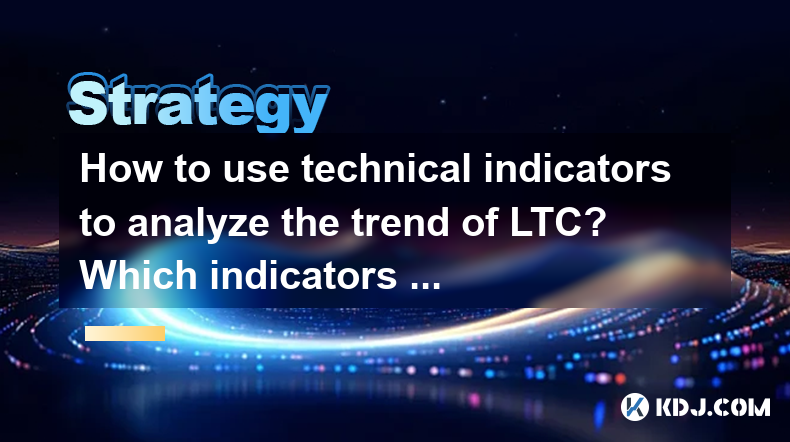-
 bitcoin
bitcoin $122659.385674 USD
0.52% -
 ethereum
ethereum $4484.113342 USD
-0.09% -
 bnb
bnb $1304.229256 USD
-0.85% -
 tether
tether $1.000204 USD
-0.03% -
 xrp
xrp $2.860636 USD
-0.51% -
 solana
solana $227.288799 USD
2.36% -
 usd-coin
usd-coin $0.999805 USD
0.01% -
 dogecoin
dogecoin $0.252837 USD
1.18% -
 tron
tron $0.341149 USD
1.12% -
 cardano
cardano $0.830507 USD
0.33% -
 hyperliquid
hyperliquid $45.792319 USD
0.04% -
 chainlink
chainlink $22.422164 USD
1.55% -
 ethena-usde
ethena-usde $1.000283 USD
0.01% -
 sui
sui $3.511389 USD
0.83% -
 stellar
stellar $0.385276 USD
-0.44%
How to use technical indicators to analyze the trend of LTC? Which indicators are the most effective?
Technical indicators like moving averages, RSI, Bollinger Bands, and MACD can help analyze Litecoin trends, offering insights into potential price movements and market conditions.
May 06, 2025 at 09:07 am

Using technical indicators to analyze the trend of Litecoin (LTC) can provide valuable insights into potential price movements and market trends. Technical indicators are mathematical calculations based on the price, volume, or open interest of a cryptocurrency, helping traders make informed decisions. In this article, we will explore how to use these indicators effectively for LTC and discuss which ones are considered the most effective.
Understanding Technical Indicators
Technical indicators are tools used by traders to predict future price movements based on historical data. They can be categorized into trend-following indicators, momentum indicators, volatility indicators, and volume indicators. Each type of indicator serves a different purpose and can be used in combination to form a comprehensive analysis strategy.
Trend-following indicators help identify the direction of the market trend. These are essential for understanding whether LTC is in an uptrend, downtrend, or moving sideways. Momentum indicators measure the speed of price changes, helping traders identify overbought or oversold conditions. Volatility indicators assess the rate of price fluctuations, which can be crucial for setting stop-loss orders and managing risk. Volume indicators provide insights into the strength of a trend based on trading volume.
Key Indicators for LTC Trend Analysis
When analyzing the trend of LTC, several technical indicators stand out for their effectiveness and popularity among traders.
Moving Averages
Moving averages are one of the most widely used trend-following indicators. They smooth out price data to create a single flowing line, making it easier to identify the direction of the trend. For LTC, traders often use the Simple Moving Average (SMA) and the Exponential Moving Average (EMA).
Simple Moving Average (SMA): The SMA calculates the average price over a specific period. For LTC, common periods include 50-day, 100-day, and 200-day SMAs. When the price of LTC is above the SMA, it suggests an uptrend, and when below, it indicates a downtrend.
Exponential Moving Average (EMA): The EMA gives more weight to recent prices, making it more responsive to new information. Traders often use the 20-day and 50-day EMAs to analyze short-term trends in LTC.
To use moving averages for LTC trend analysis:
- Choose the appropriate period: Depending on your trading strategy, select the SMA or EMA period that aligns with your time frame.
- Plot the moving averages: Add the chosen moving averages to your LTC price chart.
- Analyze the crossover: Look for crossovers where the shorter-term moving average crosses above or below the longer-term moving average. A bullish crossover (shorter-term MA crossing above longer-term MA) indicates a potential uptrend, while a bearish crossover suggests a downtrend.
Relative Strength Index (RSI)
The Relative Strength Index (RSI) is a momentum oscillator that measures the speed and change of price movements. It ranges from 0 to 100 and is typically used to identify overbought or oversold conditions in LTC.
- Overbought: When the RSI value exceeds 70, it suggests that LTC may be overbought and due for a price correction.
- Oversold: When the RSI value falls below 30, it indicates that LTC may be oversold and could be poised for a price rebound.
To use the RSI for LTC trend analysis:
- Add the RSI to your chart: Set the RSI period to the standard 14 days.
- Monitor the RSI levels: Watch for readings above 70 or below 30 to identify potential reversal points.
- Look for divergence: If the price of LTC is making new highs but the RSI is not, it could signal a bearish divergence, and vice versa for bullish divergence.
Bollinger Bands
Bollinger Bands are a volatility indicator that consists of a middle band (usually a 20-day SMA) and two outer bands that are standard deviations away from the middle band. They help traders identify periods of high and low volatility in LTC.
- Narrowing bands: When the Bollinger Bands contract, it indicates low volatility and often precedes a significant price move.
- Widening bands: When the bands expand, it suggests high volatility and a potential continuation of the current trend.
To use Bollinger Bands for LTC trend analysis:
- Add Bollinger Bands to your chart: Use the default settings of a 20-day SMA and two standard deviations.
- Monitor band width: Look for periods of contraction and expansion to anticipate potential price movements.
- Watch for price touching the bands: If the price of LTC touches the upper band, it may be overbought, and if it touches the lower band, it could be oversold.
MACD (Moving Average Convergence Divergence)
The MACD is a trend-following momentum indicator that shows the relationship between two moving averages of LTC's price. It consists of the MACD line, the signal line, and a histogram.
- MACD line: The difference between the 12-day and 26-day EMAs.
- Signal line: A 9-day EMA of the MACD line.
- Histogram: The difference between the MACD line and the signal line.
To use the MACD for LTC trend analysis:
- Add the MACD to your chart: Use the standard settings of 12, 26, and 9.
- Analyze crossovers: A bullish crossover occurs when the MACD line crosses above the signal line, suggesting an uptrend. A bearish crossover happens when the MACD line crosses below the signal line, indicating a downtrend.
- Monitor the histogram: The histogram provides insights into the momentum of the trend. An increasing histogram suggests strengthening momentum, while a decreasing histogram indicates weakening momentum.
Combining Indicators for a Comprehensive Analysis
While each indicator provides valuable information, combining multiple indicators can offer a more robust analysis of LTC's trend. Here’s how to integrate these indicators effectively:
- Confirm trends: Use moving averages to confirm the overall trend direction. If the price of LTC is above the 50-day and 200-day SMAs, it supports a bullish trend.
- Identify entry and exit points: Use the RSI to identify overbought and oversold conditions, which can help determine potential entry and exit points. For example, if the RSI indicates an oversold condition and the MACD shows a bullish crossover, it could be a good time to enter a long position.
- Assess volatility: Bollinger Bands can help assess the volatility of LTC. If the bands are narrowing and the price is approaching the lower band, it might signal a potential breakout, especially if confirmed by other indicators.
Practical Application: Analyzing LTC with Technical Indicators
To illustrate how to use these indicators in practice, let’s walk through a hypothetical scenario of analyzing LTC’s trend:
- Step 1: Set up your chart: Open your trading platform and add LTC to your chart. Ensure you have access to the indicators discussed above.
- Step 2: Add moving averages: Add the 50-day and 200-day SMAs to your chart. If the price of LTC is above both SMAs, it suggests a bullish trend.
- Step 3: Add the RSI: Add the RSI with a 14-day period. If the RSI is below 30, it indicates an oversold condition, which could be a buying opportunity.
- Step 4: Add Bollinger Bands: Add Bollinger Bands with the default settings. If the bands are narrowing and the price is near the lower band, it might signal an upcoming breakout.
- Step 5: Add the MACD: Add the MACD with the standard settings. Look for bullish crossovers to confirm potential entry points.
- Step 6: Analyze the indicators: If the price of LTC is above the 50-day and 200-day SMAs, the RSI is below 30, the Bollinger Bands are narrowing, and the MACD shows a bullish crossover, it could be a strong signal to enter a long position.
Frequently Asked Questions
Q: Can technical indicators predict LTC price movements with certainty?A: No, technical indicators cannot predict price movements with absolute certainty. They are tools that provide insights based on historical data and should be used in conjunction with other forms of analysis and risk management strategies.
Q: How often should I update my technical analysis for LTC?A: The frequency of updating your technical analysis depends on your trading strategy. For short-term traders, daily or even hourly updates may be necessary, while long-term investors might update their analysis weekly or monthly.
Q: Are there any other indicators that are effective for analyzing LTC trends?A: Yes, other effective indicators for analyzing LTC trends include the Stochastic Oscillator, the Average True Range (ATR), and the On-Balance Volume (OBV). Each of these indicators provides additional insights that can complement the indicators discussed in this article.
Q: Can I use these indicators for other cryptocurrencies besides LTC?A: Yes, the technical indicators discussed in this article can be applied to other cryptocurrencies as well. However, the effectiveness of these indicators may vary depending on the specific characteristics and market conditions of each cryptocurrency.
Disclaimer:info@kdj.com
The information provided is not trading advice. kdj.com does not assume any responsibility for any investments made based on the information provided in this article. Cryptocurrencies are highly volatile and it is highly recommended that you invest with caution after thorough research!
If you believe that the content used on this website infringes your copyright, please contact us immediately (info@kdj.com) and we will delete it promptly.
- Binance Alpha's AB Token Crash: A Cautionary Tale in Cryptocurrency
- 2025-10-09 20:45:17
- Crypto ETFs, Altcoins, and Wall Street: Navigating the New Frontier
- 2025-10-09 20:45:17
- Bitcoin's Decade of Dominance: A Super Reason to Hold for the Next 10 Years?
- 2025-10-09 20:25:15
- FUN Token, SportFun Network, and Football Fun: A Winning Play in the Crypto Game?
- 2025-10-09 20:50:11
- Joke's On You, Copyright Thieves: Datavault AI's Joke Token Revolutionizes Comedy
- 2025-10-09 20:50:11
- Joke Token, Copyright Protection, and Datavault AI: A New Era for Comedy?
- 2025-10-09 20:55:11
Related knowledge

Practical parameter settings for a Bitcoin multi-timeframe moving average system
Sep 18,2025 at 10:54pm
Optimizing Timeframe Combinations for Bitcoin Trading1. Selecting appropriate timeframes is crucial when building a multi-timeframe moving average sys...

How can I filter out false breakouts in Dogecoin high-frequency trading?
Sep 22,2025 at 01:00am
Understanding False Breakouts in Dogecoin Trading1. A false breakout occurs when Dogecoin's price appears to move beyond a defined support or resistan...

Techniques for identifying tops and bottoms in the Bitcoin on-chain NVT model
Sep 20,2025 at 07:54pm
Understanding the NVT Model in Bitcoin Analysis1. The Network Value to Transactions (NVT) ratio is often described as the 'P/E ratio' of the cryptocur...

What does the surge in open interest in Bitcoincoin futures mean?
Sep 20,2025 at 11:18pm
Understanding the Surge in Dogecoin Futures Open Interest1. A surge in open interest within Dogecoin futures indicates a growing number of active cont...

How can I use the Ethereum USDT premium to gauge market sentiment?
Sep 18,2025 at 11:55pm
Understanding the Ethereum USDT Premium1. The Ethereum USDT premium refers to the price difference between USDT (Tether) traded on Ethereum-based plat...

What should I do if Ethereum staking yields decline?
Sep 20,2025 at 06:18am
Understanding the Causes Behind Declining Ethereum Staking Yields1. The Ethereum network transitioned to a proof-of-stake consensus mechanism with the...

Practical parameter settings for a Bitcoin multi-timeframe moving average system
Sep 18,2025 at 10:54pm
Optimizing Timeframe Combinations for Bitcoin Trading1. Selecting appropriate timeframes is crucial when building a multi-timeframe moving average sys...

How can I filter out false breakouts in Dogecoin high-frequency trading?
Sep 22,2025 at 01:00am
Understanding False Breakouts in Dogecoin Trading1. A false breakout occurs when Dogecoin's price appears to move beyond a defined support or resistan...

Techniques for identifying tops and bottoms in the Bitcoin on-chain NVT model
Sep 20,2025 at 07:54pm
Understanding the NVT Model in Bitcoin Analysis1. The Network Value to Transactions (NVT) ratio is often described as the 'P/E ratio' of the cryptocur...

What does the surge in open interest in Bitcoincoin futures mean?
Sep 20,2025 at 11:18pm
Understanding the Surge in Dogecoin Futures Open Interest1. A surge in open interest within Dogecoin futures indicates a growing number of active cont...

How can I use the Ethereum USDT premium to gauge market sentiment?
Sep 18,2025 at 11:55pm
Understanding the Ethereum USDT Premium1. The Ethereum USDT premium refers to the price difference between USDT (Tether) traded on Ethereum-based plat...

What should I do if Ethereum staking yields decline?
Sep 20,2025 at 06:18am
Understanding the Causes Behind Declining Ethereum Staking Yields1. The Ethereum network transitioned to a proof-of-stake consensus mechanism with the...
See all articles


























![🚨IS VECHAIN (VET) A DEAD COIN ?? PRICE ANALYSIS [GET READY NOW] 🚨IS VECHAIN (VET) A DEAD COIN ?? PRICE ANALYSIS [GET READY NOW]](/uploads/2025/10/09/cryptocurrencies-news/videos/vechain-vet-dead-coin-price-analysis-ready/68e7b200b067b_image_500_375.webp)















































